What the … ?
When I give a talk at trade shows and growers’ meetings I always ask my audience to send me questions or pictures for identification. You’re welcome to send me stuff, pictures and questions too! I can always use a good mystery for this segment of PestTalks.
John Pierson of Greener Earth in Blackville, South Carolina, attended one of my talks and took me up on the offer. He sent me a picture in mid-February asking what might have caused the holes on this crape myrtle bark. The owner of the tree insisted that the holes were created by some kind of borers, but John thought someone had shot the tree with birdshot. (What? Y’all don't do that?) The trunk has healed and shows no sign of injury, but the holes remain.
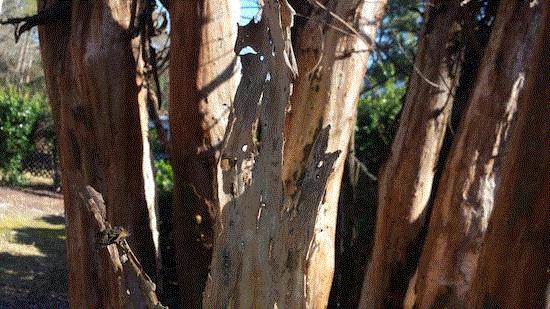
What do you think created those holes on the bark?
Crop Protection Guide available from OMAFRA
The Ontario Ministry of Agriculture, Food and Rural Affairs (OMAFRA) released its latest Crop Protection Guide for Nursery and Landscape Plants (Publication 840) on February 11. The guide has three main chapters—a chapter on use and licensing of pesticides and pesticide applicators in Ontario, and two chapters on using pesticides to manage insects, mites, diseases and weeds.
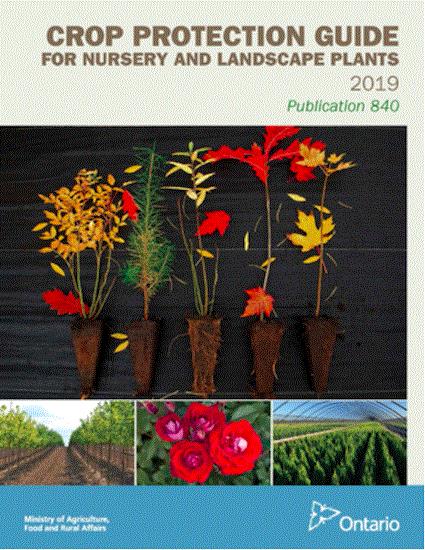
My attention is naturally drawn to the chapter on insects, mites and diseases. The chapter has a table listing the pests, products and application rates used to manage them, and notes on the life cycle, biology, scouting, treatment timing, etc. The products listed in this guide have trade names different from those in the United States. But, that’s okay. The active ingredients are still the same, and the general biological information is also useful.
The chapter starts with two tables on honeybee and mammalian toxicities, which I thought was a good idea. I think I’ll duplicate this good idea in my next pest management guide. Get a free online copy of the OMAFRA Crop Protection Guide by clicking here.
Also available is the OMAFRA Guide to Nursery and Landscape Plant Production and IPM (Publication 841), which is a companion to the OMAFRA Crop Protection Guide. This publication is a detailed technical guide to the production and pest management practices on outdoor ornamentals. The information is presented in four major chapters: Soil, media and water quality management; Insect and disease management; Rodents and deer; and Weed management. You can get a free online copy from here.
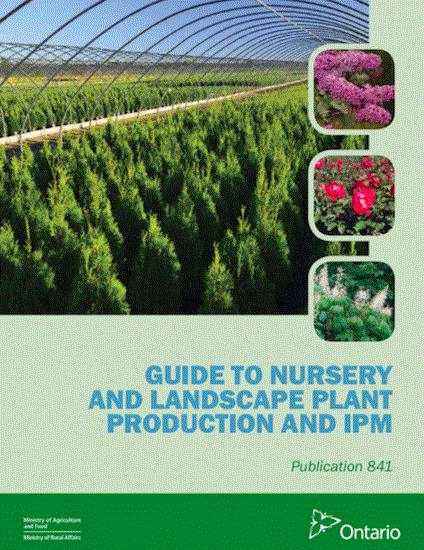

Box tree moth
My neighbors to the north didn’t rest this winter—they were busy publishing pest management guides and being super productive. Well, in fact, they couldn't rest. The Canadian Food Inspection Agency (CFIA) confirmed the presence of box tree moth in Ontario (and the first report in Canada) in November 2018. The first detection was made not by CFIA inspectors but through a picture submitted to iNaturalist (a social media site for naturalists and citizen scientists) in September 2018. Infestations were detected on boxwoods in residential areas in Etobicoke, Ontario. When it’s warm enough, CFIA will conduct extensive surveys to determine if this is an isolated incident or more widespread.
The box tree moth is native to East Asia (China, Japan and Korea), but spread to southwestern Germany and the Netherlands in 2007. Since then, it has spread throughout Europe and the Russian Far East. There is speculation that the moths were introduced to and spread throughout Europe through boxwood plants and topiaries from China and other infested regions within Europe. Landscape plants imported from Italy for the Winter Olympics were suggested as the source of infestation in Sochi, Russia, and the Caucasus region. The box tree moth devastates landscape plantings of cultivated boxwoods and threatens native boxwood species in Europe.
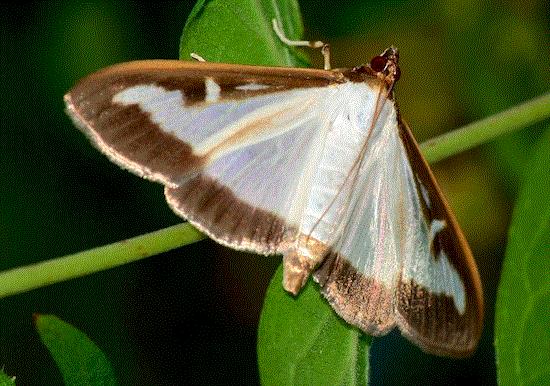
An adult female box tree moth. (Photo credit: Florine Leuthardt, University of Basel)
I didn’t want to congratulate our neighbors on their dubious distinction of being the first North American country to be invaded by the box tree moth. That’s just mean. The box tree moth is not currently established in the United States. But we do need to keep an eye out for this pest because there is nothing stopping them from spreading to the United States through infested plant materials or other means.
The box tree moth appears to attack boxwoods only. But, research in the Netherlands showed that the caterpillar could also feed on Pachysandra terminalis and Euonymus fortunei (although euonymus didn't support reproduction). The caterpillars, which are light green with black stripes and white dots down the back, can grow to 1.5 inches (4 cm) and completely defoliate a boxwood bush. Without management, the defoliation can kill a bush. The attacked bush will also be covered with webbing. Adults have a wingspan of 1.5 inch (4 cm). The wings are white and iridescent, with brown margins. There are two white spots on the front wings.
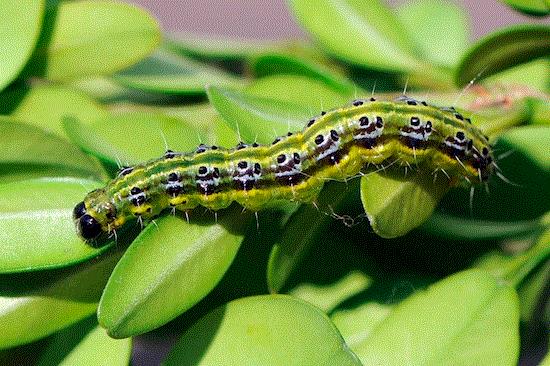
Box tree moth caterpillar. (Photo credit: Friedrich Boehringer, Wikimedia)
Few caterpillars feed on boxwood, and none will make webs on the bush. If you see something that looks like the box tree moth caterpillar and webbing is present on the attacked bush, contact your local extension agents and specialists or your state department of agriculture. If we find the infestation early, we can help snuff out the fire.
Boxwood has enough troubles already—mites, psyllids, blight, leafminers. It surely doesn’t welcome another devastating pest.
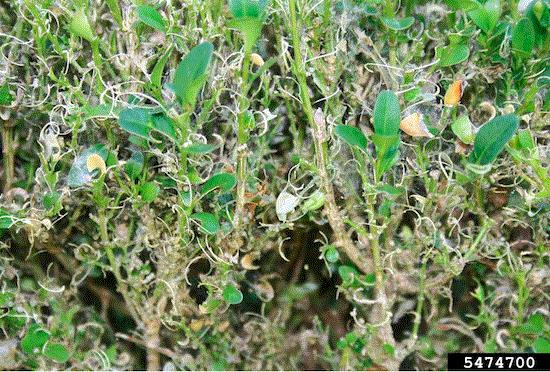
Defoliation and webbing by the box tree moth. (Photo credit: Ferenc Lakatos, University of Sopron, Bugwood.org)

Spotted lanternfly summit
Last week, I attended the Spotted Lanternfly Green Industry Summit, hosted by Pennsylvania State University Extension and Bartlett Tree Experts. The summit gathered researchers, state and federal regulators, extension personnel, landscape professionals, growers,representatives of insecticide manufacturers, distributors and other segments of the green industry (most of us from the eastern United States) all under one roof. My friend Gary Chastagner of Washington State University joined us because transportation of egg masses and insects (dead or alive) via Christmas trees and other horticultural plants could quickly become a pest management and regulatory nightmare.
The summit functioned as a platform for information sharing, resource development and research planning. Penn State Extension has a great website full of up-to-date information and resources on the spotted lanternfly. Yes, I could just go to the website and learn about this beast, but it’s so much better learning directly from the experts at a face-to-face meeting. What can I say? I’m old-fashioned.
I learnt quite a bit at the summit, judging from my eighteen pages of notes. With the new information I got on biology, behavior, host selection and management, I feel more prepared than ever for the eventual arrival of spotted lanternfly in my neck of the woods. I’m not being pessimistic, but realistic, about the chance of invasion. With I-85, I-95 and major railroads cutting through the Carolina landscapes, it’s just a matter of time before I have to field calls from panicked professionals and homeowners.
I’ll hold off on sharing the information I have learnt at the summit. Instead, I’ll use it as bait. If you want to learn about the latest in dealing with box tree moth, spotted lanternfly, and other insects and diseases, you’ll have to get yourself a copy of the April issue (a.k.a. the “all-about-pests” issue) of GrowerTalks.
Pollinator preferred plants training module
The IR-4 Project, the Protecting Bees Project and the American Phytopathological Society’s Plant Management Network (APS PMN) Pollinators Hub have developed a web-based learning module on Woody Plants for Urban Bee Conservation. The learning module was developed by Drs. Dan Potter and Bernie Mach of the University of Kentucky, and Carolina Simao of IR-4 and Protecting Bees Project. The module focuses on the preferred plant species of bees in urban landscapes and is based on Bernie’s research.
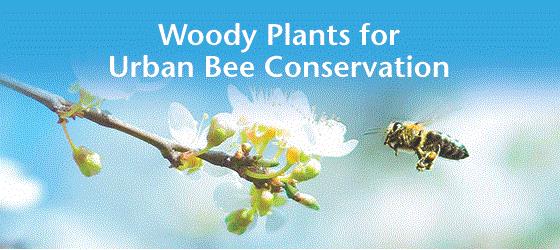
The webcast, podcast, downloadable slides and study guide of the Woody Plants for Urban Bee Conservation are available from the APS PMN’s Pollinators Hub. You can also find other relevant resources there. Y’all can access the Pollinators Hub through the Protecting Bees Project website or the Pollinators Hub.
Answer to "What the ... ?"
I don't really know what happened to John’s friend’s crape myrtle. My best guess? That’s just a natural part of the bark. Notice that the trees in the background (kind of fuzzy, I know) have bumps on the trunk? I think if John matches the bark to the trunk, the holes will match perfectly with the bumps. Some crape myrtle species have these bumps on their trunk. (Shoot! Good luck asking a bug nerd what these bumps are called.) These bumps may have created dimples on the bark. As the trunk expands, the dimples caused by the bumps on the bark also expand and become holes.
That’s my best guess. What do you think? I always believe that two heads are better than one. So, send me an email and let me know what else you think might be going on here.
See y'all next time!

JC Chong
Associate Professor of Entomology at Clemson University
This e-mail received by 24,895 subscribers like you!
If you're interested in advertising on PestTalks contact Kim Brown ASAP!